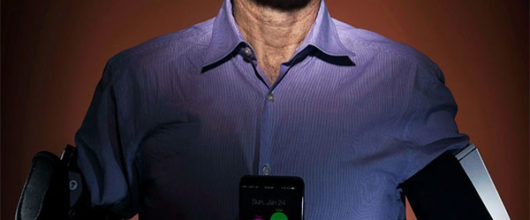Personal Radiation Detector | RadPavise-H Features: 2. Work with surface contamination probe RadProbe-AB 3. Support for indoor & outdoor positioning capabilities Applicatioin: Source search and localization RadPavise can work together with external probe RadProbe-AB to measure Alpha and Beta.
Read More
X-Z LAB’s Personal Radiation Detector RadPavise used by Xinhua News Agency in Fukushima
Last month, Xinhua journalist Hua Yi visited the Fukushima Daiichi nuclear power plant along with other reporters under the invitation of Tokyo Electric Power Company, Inc. (TEPCO). Armed with RadPavise | Personal Radiation Detector, Hua recorded the increasing levels of radiation as they neared the power plant. 24 km from the power plant, the reading was 0.114 µSv/h, twice that of Tokyo. At 5 km, the reading jumped to 5–10 µSv/h, more than 100 times greater. Inside the power plant itself, the radiation level was as high as 150 µSv/h. Read full article
Read More
RadWall M | Area Radiation Monitor installed at University of Chicago’s cyclotron research facility
The University of Chicago opened up its cyclotron research facility in January, making it the only medical institution in Illinois with an operational cyclotron. The cyclotron will allow UChicago to manufacture radioactive isotopes in-house for research. The cyclotron program is directed by Dr. Richard Freifelder. In this video, Dr. Freifelder sets up RadWall M | Area Radiation Monitor in the facility to ensure safety for the researchers.
Read More
RadTarge II in Stanford Wearable Biosensors Study
In a recent study led by Mike Snyder and Xiao Li of Stanford University, physiological data gathered from wearable biosensors were found to be useful indicators of an individual’s health. RadTarge II D700 was used to measure personal radiation exposure over a six month period. The information collected revealed heightened radiation exposure “during airline flights or during chance encounters with individuals or locations with high radiation. Most importantly, it demonstrates that simple personal wearable devices can identify these levels and provide immediate feedback.” Read the full study (Digital Health: Tracking Physiomes and Activity Using Wearable Biosensors Reveals Useful Health-Related
Read More
The connection between radiation exposure and Alzheimer’s disease: study
A recent study suggests that radiation exposure can contribute to the development of Alzheimer’s disease. Researchers at the University of Southern Denmark administered low-dose-rate ionizing radiation treatments to two groups of mice. One group received a cumulative dose of 0.3 Gy at a rate of 1 mGy over 24 hours, while the other received 6.0 Gy at 20 mGy over 300 days. In both groups, the hippocampus sustained molecular changes similar to those found in Alzheimer’s patients. Source: University of Queensland The hippocampus, which is responsible for learning and memory formation, is known to be negatively affected in Alzheimer’s patients.
Read More
Leak at nuclear reactor in Norway is contained: operator
A leak at a small nuclear reactor in Halden, Norway, has been contained, according to its operator. No immediate danger to staff or the surrounding environment has occurred. Atle Valseth, research director at the Institute for Energy Technology, estimated that up to 8 employees were present during the leak. The crew evacuated as soon as the leak was detected and did not receive hospital treatment as the dose they received was low. Although the incident occurred on Monday, the Norweigian Radiation Protection Authority (NRPA) was not alerted until the following day. The regulator is investigating the circumstances that caused the
Read More
RF radiation awareness promoted by construction groups
In an attempt to inform employers and labor organizations about the risks of radiofrequency radiation, the Center for Construction Research and Training (CPWR), Roofing r2p Partnership, and the RF Radiation Work Group worked together to develop the Radiofrequency (RF) Radiation Awareness Program for the Construction Industry. Workers may be exposed to radiation when they work on building structures close to radiofrequency-generating devices. Overexposure may lead to adverse health effects, such as blindness, burns, and sterility, warns CPWR. Risk factors include the number of devices, the proximity of the worker to a device, and time spent near the device. Full
Read More
Radiation protection plans for astronauts evaluated by NASA
Ahead of the launch of the Orion spacecraft, NASA is evaluating radiation protection plans for astronauts when they go into deep space. Engineers, astronauts and designers are conducting testing in a representative model of the spacecraft. Designers of the Orion capsule are also testing their plan to help astronauts escape from radiation in space. In the even of a radiation incident, astronauts will take shelter and create a fort around them using their supplies. Full Article
Read More
Children’s radiation safety overlooked, say pediatricians
Children’s radiation safety is being overlooked and must be addressed, according to doctors Alan Schroeder, of Stanford and James Duncan of Washington University in St. Louis. The pediatricians published a Viewpoint article in JAMA Pediatrics urging for increased attention to the amount of ionizing radiation children receive. Information campaigns such as Image Gently have been documented to successfully bring radiation safety to the forefront at children’s hopsitals. However, a lot of imaging is provided outside of the hospital setting, allowing for too much variability, the authors argued. Additionally, individual hospitals can remain anonymous with no accountability for excessive imaging. To
Read More
Radiation protection gene discovered in tardigrades
Japanese researchers discovered a radiation protection gene in a small animal named the tardigrade. Source: sciencenews.org Tardigrades, also known as water bears, are resilient organisms able to survive through extreme temperatures, outer space, high pressures, and intense radiation. After decoding the entire genome of the Ramazzottius varieornatus tardigrade, the scientists found a protein that may be key to resisting high amounts of radiation. Named Dsup for Damage Suppressor, the protein protects DNA from being damaged when it is irradiated. In the study, human cultured cells exposed to X-rays had their DNA damaged. When given the ability to produce Dsup, the
Read More

